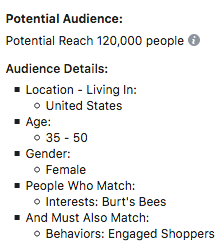One of the first things we teach our new ResultFlow users about is audience targeting.
Why is this so important that we literally don’t want people to touch the software until it’s done?
Audiences are like Keywords
The audiences that you target on Facebook are a lot like the keywords you use for search ads. They define who you’re going to reach, and how much it’s going to cost you to reach them.
The biggest culprit in PPC campaign failures is the use of “broad match” keywords, and the biggest reason why Facebook campaigns fail is that they target an audience that’s simply too broad to reach effectively.
Just like with pay per click campaigns on Google Ads, going too broad means that you pay too much for low quality traffic. So how do we fix this?
Match Audience Size to Budget
One of the best things about Facebook ads is that almost *any* budget can be effective, if everything else is right, but whatever your budget is for a campaign, the budget limits the number of people you can reach.
What this means is that there’s no point in targeting an audience of 2.7 million people, when your budget is only going to allow you to reach a few hundred or a few thousand per day.
Instead, refining and narrowing your audience to fit your budget allows you to increase the ROI of your campaigns, in the same way that exact match keywords work better in PPC campaigns than broad match.
How About an Example?

This targeting is probably better than what you’re using.
The targeting here is very good – they’re after women, age 30 and up, who are interested in a related brand, and we’re using Facebook’s behavioral category for “engaged shoppers,” which is made up of people who have pushed a “buy” button on a Facebook ad in the last 30 days.
A lot of people would tell you to just throw a bunch of money at that audience, wait for the Facebook Pixel to learn who the buyers are, and everything will be just dandy. You might get lucky and become one of their cherry-picked case studies, who knows.
Unfortunately, the budget here, at the development stage, is $5 per day… and $5 isn’t going to reach 280,000 people.
To get the best ROI, the largest audience you should even consider targeting should be no more than your monthly budget times 1000. In this case, $5 per day is $150 per month, so we’d like to get that audience size down below 150,000 people.
Narrower Audiences = Better ROI

Narrowing the age range gets us to 120,000
The customers for this product include women as young as their late twenties, but the prime time in life for buying these products is between the ages of 35 and 50. So, we’re going to focus on this age group, who should be our best customers, and most likely to be interested in our offers.
This tiny change will not reduce the number of people his campaigns reach at all. In fact, it’s rather the opposite. By targeting people who are more likely to be interested, we actually reach more people within our budget, not less.
That’s because the new audience is more likely to Engage (like, comment, click, or share) with our ads.
Why Engagement Is Everything
Okay, engagement isn’t actually everything, but it’s the single most overlooked factor in the Facebook algorithm, even though it plays a critical role in determining how many people you reach, and what it costs to reach them.
In fact, with a tightly focused audience and the right messaging, it’s not unusual to reach 3-5 times as many people for free, thanks to people who see your ad sharing it with their friends and other contacts on Facebook.
But engagement also works a lot like click-through rate does for search advertisers, and an ad that gets above average engagement actually gets a performance boost in Facebook’s newsfeed algorithm, which means you pay less to reach more people.
Fixing This Can Double Your ROI

Dan Thies
Heck, it’s not unusual to see the profitability of a campaign double with this one simple step.
However, if you want to make the most out of your budget, there’s still one more problem you’ve got to fix, because that funnel you’re running is totally wrong, and you can easily double your performance again if you build a “piggyback” funnel.
I’ll explain what that means in the next installment, “Why Facebook Ads Fail #2 – Headless Funnels!”
Thanks for reading!
Dan Thies
Leave a Reply